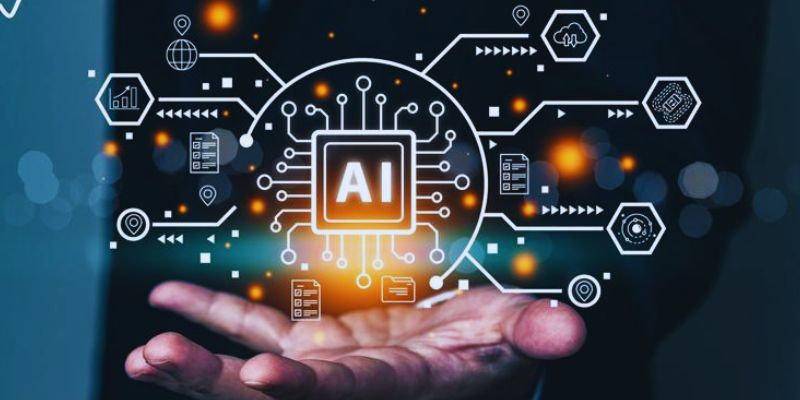Artificial intelligence is rapidly evolving and making a mark in the technological world. It improves decision-making, revolutionizes businesses and industries, and makes our lives easier. Given its multiple benefits, why have not all industries shifted to AI models?
Companies face barriers to AI adoption, which prevent them from fully utilizing AI. These include a lack of vision, insufficient AI expertise, a lack of innovative culture, budget and cost, privacy and security concerns, legacy system issues, a high carbon footprint, data quality and availability, limited knowledge, and bias and ethical concerns. Let’s understand all of these issues in detail here!

The more AI makes progress, the more difficult its adoption becomes. If you plan to shift your work to AI, you should know the challenges that might come your way. Here are some prominent challenges with solutions so that the whole process will be convenient for you and you choose the right path for the application of AI:
The most common challenge companies face during AI adoption is a lack of a clear, strategic vision. AI is only effective when you develop effective strategies for its successful implementation. You must first do enough research about AI tools and their use and then incorporate it into your business. Carefully analyze your business's important parts and processes and then decide where to utilize AI to have the most significant impact on the business.
AI-powered projects only succeed when you have the skills to use the AI tools correctly and efficiently. Many companies and organizations think that AI is just another tool anyone can use. But that's not right. Train your employees and make them skilled enough before jumping to using AI. It would be better to recruit an AI professional or specialist to give training so that the employees don’t face problems every other day. The specialists should teach them how to apply AI systems in daily life. These are the top training formats for AI:
The need for and importance of innovation in technology and business cannot be denied. When it comes to AI implementation, trying out new ideas and techniques is necessary for the growth of your business. Unfortunately, most organizations allow employees to try new ideas without fearing loss and mistakes. And that’s why the workers fail to learn and discover something unique that would benefit the company. To build an innovative culture, businesses should celebrate efforts, motivate employees, and improve cross-departmental collaboration. Experimentation and open communication should also be encouraged.
Companies face a big challenge with the cost and budgeting of AI adoption. They don’t spare funds for AI, and when the budget is limited, AI cannot produce significant results. To fix this problem, businesses should allocate some budget, especially for AI, and give preference to short—and long-term strategies. The phase investment approach is an effective technique where you start from small-scale projects. When the outcomes are according to your desire, you can expand your budget and adopt AI for your large-scale projects.
Privacy and security concerns are another problem that prevents businesses from fully adopting AI. When companies process their private and sensitive data through AI tools, they are concerned about trust and security. But that doesn’t mean you should not use AI. The solution to this problem is that they can implement governance frameworks that reduce the risk of misuse of their important data. In this way, businesses no longer have to be worried about privacy breaches.

Another challenge is the legacy system, which can cause technical issues. There might also be compatibility and flexibility problems, which can hinder businesses' AI adoption. Businesses fear that their outdated technological systems are unsuitable for modern AI tools. But we have good news for you. You can start with AI without updating your organization's legacy system. You can use APIs and middleware, making AI adoption with your existing system easier.
If you want to use AI models for your business, you need high-quality data. However, the problem is that most companies are working with poor-quality data, which can result in many inaccuracies. It can also undermine even the advanced AI models. So, before integrating AI, you should establish a data governance strategy and improve the quality of your data if needed. Ensure all your important data is well-organized, clean, and readily available for applying AI and automating your tasks.
AI systems, especially those with larger datasets and more powerful tools, use large amounts of energy and, hence, have a high carbon footprint. It means they negatively impact your environment if they make your work easy, another challenge businesses face while adopting AI for their daily tasks. The solution is to adopt energy-efficient algorithms and green technologies and optimize computing resources to reduce the carbon footprint and simplify your work simultaneously.
The development and application of AI models in various sectors, including daily life, impose serious ethical issues. Questions are raised regarding the social impact of bias and violations. Fields like health and criminal justice need to focus more while implementing AI because there is an increased demand to follow ethical principles in these sensitive sectors. The bias in AI results in unfair treatment regarding hiring procedures, law enforcement, and loan approvals.
AI is undoubtedly a powerful tool and knows it all, but it can never have more knowledge than a human being. Whether using AI tools to write content for you, make images, or do any calculations, you should never fully rely on it. Overreliance on technology can lead to errors. You always need to cross-check the AI-generated results and make corrections if there are any mistakes. Especially when writing content through AI, you should edit it to give it a human touch and avoid plagiarism.
Suppose you are wondering whether you should integrate AI-powered modes in your business. The answer is that you definitely should because it can take your business to greater heights. But before that, note that AI has some challenges in business. These are limited knowledge of AI, ethical issues, privacy and security concerns, high carbon footprint, lack of vision, data quality and availability, lack of innovative culture, cost, and insufficient skills. You should have a strategy to avoid these challenges, and then you're good to go.

Learn AI and machine learning for free in 2025 with these top 10+ courses from leading platforms, universities, and tech experts

Discover how Microsoft Drasi enables real-time change detection and automation across systems using low-code tools.

Boost teacher productivity with AI-generated lesson plans. Learn how AI lesson planning tools can save time, enhance lesson quality, and improve classroom engagement. Discover the future of teaching with AI in education

Explore IBM Granite-3.0's setup, features, and real-world uses in AI. Learn to deploy it efficiently for enterprise tasks.

Discover five powerful ways computer vision transforms the retail industry with smarter service, security, shopping, and more

ChatGPT helps improve your listings by identifying SEO mistakes, correcting keyword issues, and enhancing content clarity—without losing your brand’s tone

remove duplicate records, verification is a critical step, SSIS provides visual tools

Know how computer vision transforms sports with real-time player tracking, performance analysis, and injury prevention techniques

Learn the nine biggest benefits of using AI in retail, from personalized experiences to cost savings and smarter decision-making

How open-source AI projects and communities are transforming technology by offering free access to powerful tools, ethical development, and global collaboration

Explore the differences between Llama 3 and Llama 3.1. Compare performance, speed, and use cases to choose the best AI model.

AI in Cybersecurity is changing the way businesses handle threat detection. Discover how advanced AI systems prevent cyberattacks with faster and smarter protection